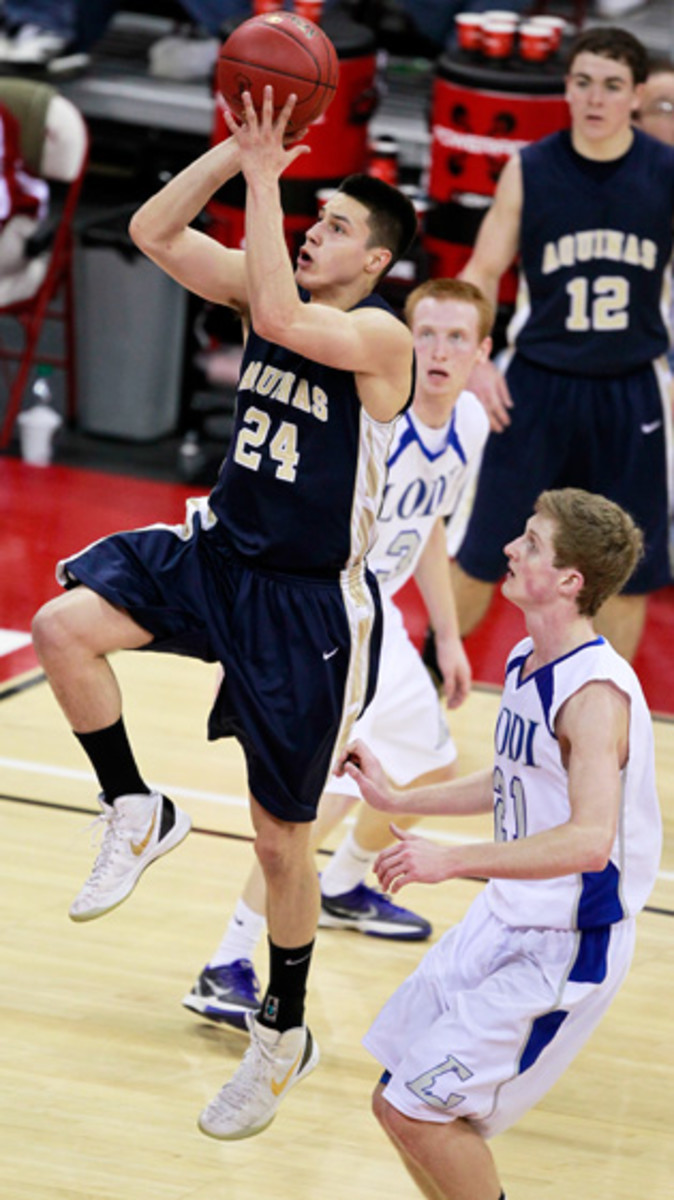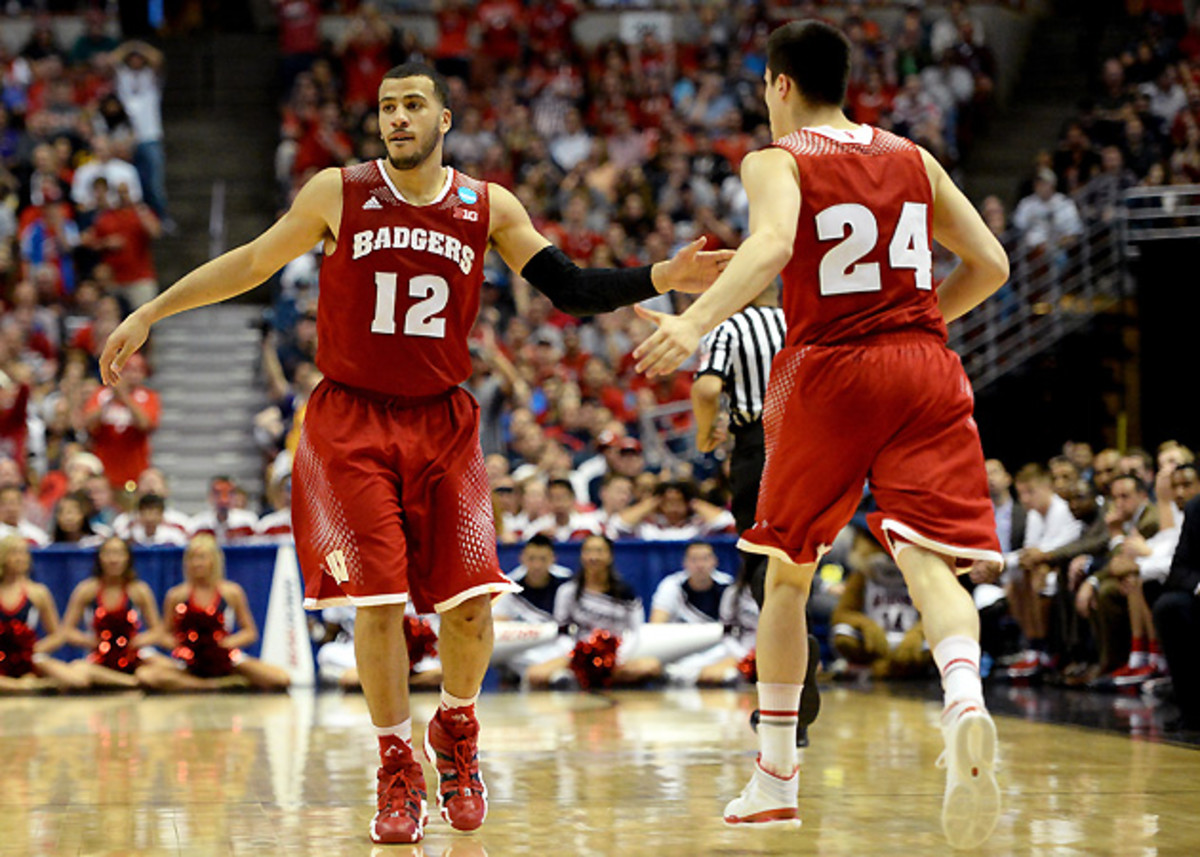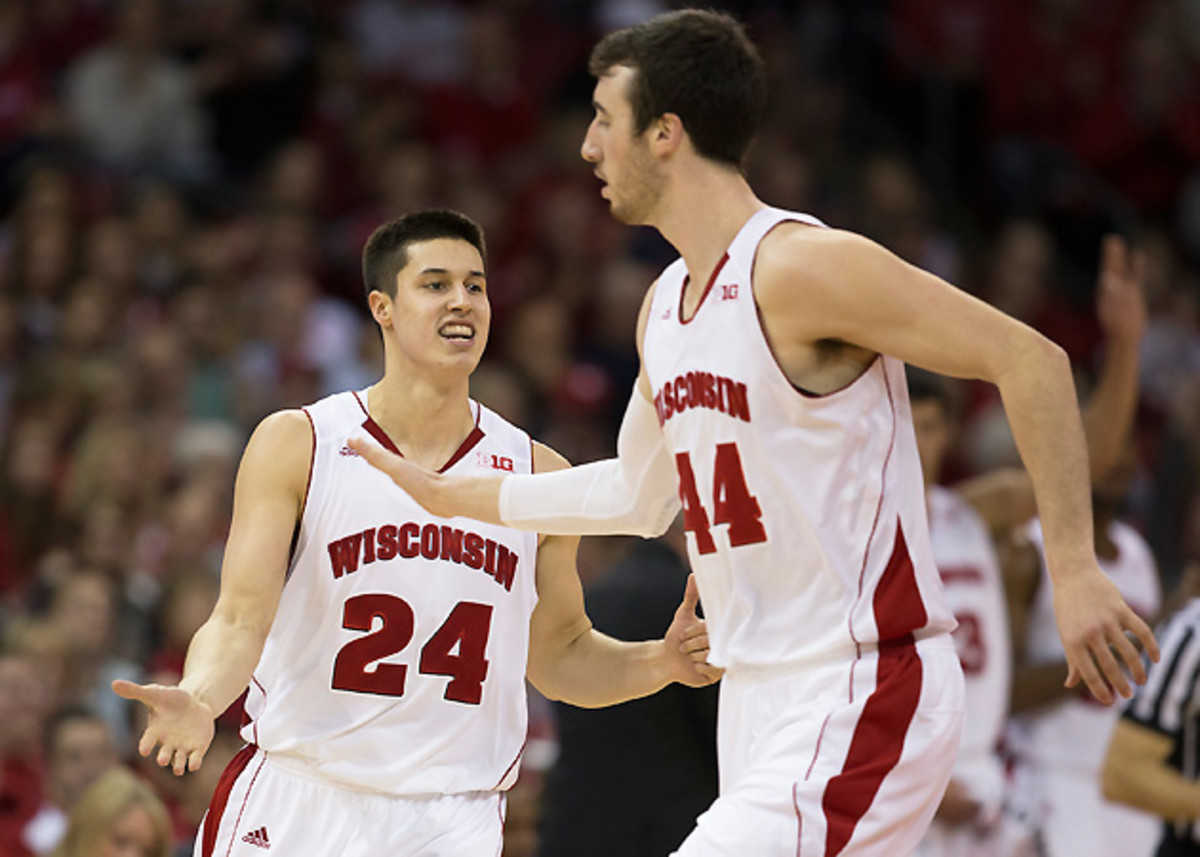Koenig relishes growing roles with Wisconsin, Native American tribes

MADISON, Wis. -- The name of the class, plainly enough, is Indians of Wisconsin. The University of Wisconsin’s American Indian Studies department offers it regularly, and because Bronson Koenig is accustomed to identifying the correct course to take, signing up for it last spring only made sense. He can trace the Native American bloodline on his mother’s side back to a time before his ancestors had Anglicized names. As a member of the Ho-Chunk tribe, he had been exposed to the culture since he was a child, attending occasional large powwows near Black River Falls, watching from the periphery as dancers of all ages moved to the beat of the drums.
Taking the class was the natural thing to do. Taking the first test was something else entirely
“[It] was harder than I expected,” Koenig says. “It was a little embarrassing.”
When Koenig recounted the story in the team’s practice gym one recent evening, the lesson was clear: Self-discovery isn’t always easy. The Badgers (18-2) are ranked No. 5 in the nation and are eyeing their second straight Final Four appearance. They are also without Traevon Jackson, the senior point guard and assist leader who started the first 17 games before breaking his foot on Jan. 11. One of the most challenging positions on one of the nation’s elite teams instantly fell to Koenig, who had told himself to stay ready should something happen while never expecting it would.
• MORE CBB: Frank Kaminsky talks teammates, karaoke in Q&A
What happened next -- the Badgers winning the three games Koenig has started at the point, with the 6-foot-4 sophomore guard scoring in double figures in four straight outings -- has helped Wisconsin remain atop the Big Ten and Koenig continue to grow into a leader. A year ago, Koenig was stumped on what plays to call coming out of timeout huddles. A year ago, he didn’t fully comprehend the impact he could have for a people craving a model set by high-achieving Native American athletes, of which there are few. Now the former Wisconsin Mr. Basketball, who logged 15 minutes per game last season, has a more crystallized vision of his role, and who he is.
“He understands the responsibility he has,” Jackson says. “I can just see it. He understands it now -- what he does as the head of the team, with the ball in his hands most of the time, he has to be that rock.”
*****
Koenig’s mother, Ethel Funmaker, has a family tree. She doesn’t have it handy for easy reference, but she knows that it includes family members’ names that are not written in English. They are Ho-Chunk names, predating any appellations given by white settlers. “I don’t remember how far it goes back,” Funmaker says, “but it goes way back.”
According to the tribe’s website, the Ho-Chunk occupied more than 10 million acres of land in what would become Wisconsin, Iowa, Nebraska and other states, before first contact with the French occurred in 1634. The tribe is now perhaps most commonly known for running six casinos in Wisconsin, including one on the eastern tip of Madison, in plain sight of passing motorists on I-90.
Koenig grew up in La Crosse, Wis., a city of about 50,000 on the Mississippi River, where he was introduced to his heritage but not saturated with it. The family attended the powwows, the large, multi-day Native American gatherings held most notably on Memorial Day and Labor Day weekends, unless Koenig had basketball conflicts. After school, he often spent time at the Ho-Chunk youth and learning center on Main Street in La Crosse; his mother wanted to be sure he interacted with other native children. Koenig was free to be himself, but he received enough exposure to native culture to know it was a part of him. “I said, you don’t know what you will be doing in the future,” Funmaker says. “You may need your tribe, your people.”

As he became a Top 100 recruit, a two-time state champion and the Wisconsin Player of the Year as a senior, the dynamic gradually shifted to how Koenig’s tribe needed him.
According to the CDC’s most recent health disparities report from January 2013, 18.8 percent of the American Indian/Alaska Native population did not complete high school, the second-highest figure among race/ethnicity subsets. The number jumps to 26 percent of adults aged 18 to 24. Prevalence of binge drinking ranked second-highest to non-Hispanic whites, but the intensity of binge drinking (8.4 drinks per episode) was highest among all groups. Smoking prevalence was down but still highest among subsets at 34.4 percent. Diabetes in particular has beset the Ho-Chunk, according to the nation’s president, Jon Greendeer; in 2010, the CDC listed it as the fourth-leading cause of death for Native Americans. All told, the estimated percentage of American Indian/Alaska Native adults who rated their health as fair or poor was 30.8 percent as of 2010, the highest figure of any group.
Remedying these serious issues requires much more than one role model, but pointing to examples of successful athletes can offer. The issue is the lack of such role models; according to NCAA figures, just 14 men and 28 women identified as American Indian/Alaskan Native basketball players in 2013-14, of 10,393 total.
“Bronson has looked outward and upward,” Greendeer says. “When you see someone like Bronson who epitomizes great health, you want to be that. He carries with him an aura of energy and excitement. That energy is very intoxicating. People want to be a part of that. That’s where they’d like to see themselves.”
After his high school success, he began to realize he might carry a responsibility to natives in Wisconsin and beyond, without having much say in the matter. After Wisconsin’s Final Four run, he knew beyond a doubt. The requests from tribes began to arrive -- “He gets more than he can ever handle or fulfill,” Wisconsin assistant coach Greg Gard says -- all of them hopeful that Koenig might speak to their people and tell his story and offer what motivation he could.
“It made me realize how much of an inspiration I can really be,” Koenig says of the attention over the last year. “With the reservations they live on, and the high crime rates, and suicide and alcoholism, it’s definitely important for them to have somebody to look up to. I hope I can kind of inspire them to get off those reservations, expand their horizons and become athletes themselves.”
How did Mike Krzyzewski reach 1,000 wins? With a million small steps
Cherie LaPointe, the director of a youth empowerment program for the Winnebago Tribe of Nebraska, was the first to book Koenig for an inspirational talk. She had followed Koenig since high school, and discovered last March that he would be playing at Nebraska. She asked Funmaker if Koenig would speak to the Winnebago boys’ basketball team on the trip.
"We wanted the boys to hear what he had to go through and how hard he had to work to get to where he is," LaPointe says.
The Winnebago group drove more than 100 miles to listen to Koenig’s story. The trick was Koenig managing to tell it. “I was a little more nervous about that than the game, to be honest,” he says. He claims he had no prepared remarks and no one told him what to say. There are those who remember it differently. “He probably studied that speech more than he did the scouting report,” Gard says.
In a hotel conference room, Koenig spoke about his upbringing and basketball. He emphasized the need for the boys to attend to academics and stay away from substance abuse. He told them to have the courage to leave the reservation. Then he autographed pictures -- brought by LaPointe -- and accepted a Winnebago basketball T-shirt. A little less than a year later, LaPointe notes the speech's impact: Two of her grandsons are on the Winnebago team and were in that audience, and they have attacked academics with a new vigor to become 3.0 students. They came two hours for inspiration and found it.
*****

If he continues his ascent at Wisconsin, Koenig's growth as a role model for Native Americans everywhere will be expedited as well. In four starts, Koenig has averaged 12.3 points and 2.5 assists in 35.5 minutes while shooting 56.7 percent from the floor and 52.6 percent (10 of 19) from three-point range. His assist-to-turnover ratio of 4.3-to-1 ranks second nationally to Iowa State’s Monté Morris. “In terms of a prepared backup, I don’t know if we’ve had one as ready as Bronson,” Gard says.
Maybe this is why Jackson seems so at ease after scooting into a Kohl Center players’ lounge recently, still at least a month away from a return. Late on the Monday following Jackson’s injury, Koenig texted the Badgers’ floor leader some heartfelt thoughts. He wrote that he’d pray for Jackson. He thanked Jackson for his help on and off the court. You don’t know how much you’ve taught me, Koenig wrote.
Jackson replied at 12:23 a.m.: It’s your time to lead them boys out there and play how we all know you’re capable of playing. No fear, no doubt. Just go out there and play free and unafraid… Play with some joy and enjoy the moment bro. I’m here for you every step of the way. You’re going to be one of the best PG’s to ever come out this university.
“It definitely put a smile on my face when I read it,” Koenig says.
"He began to approach the new role with new purpose. Instead of quickly retreating home after practices, Koenig now lingers an extra hour to foam-roll his muscles out or plunge into the cold tub, mindful of the increased minutes he'll play. On the floor, he concentrated on rekindling his naturally instinctive, aggressive game, after too often playing and acting tentative in his first year and a half. In a recent win over Iowa, the sophomore created separation against a defender with a step-back move but didn’t hoist a shot, conscious that it was too early in the possession. The Badgers didn’t score on the trip. At halftime, Jackson prodded Koenig to let it fly if he was that open."
• MORE CBB: Monte Morris driving Iowa State's Final Four dreams
In the second half, Koenig stoked the crowd with a between-the-legs step-back dribble he finished with a jumper, and Jackson nodded in approval. “Now I’m literally just letting it go,” Koenig says. “It feels a lot better. I’m just catching the ball and shooting. I don’t think about it at all.”
And when he must think, he is more comfortable. Most Badgers timeouts end with coach Bo Ryan asking his point guard what play he’d prefer to run. When Koenig fielded this question early in his career, or even earlier this year, he either deferred to a veteran or so reflexively went to incredibly basic calls -- either Wisconsin’s standard “Swing” set, or simple ball-screen actions named “Blast” and “GB.”
As Koenig’s court time has increased, and as his confidence has spiked, he is playing and reacting more on feel “Just this past couple weeks, he’s the one taking charge, he’s calling plays and seeing different reads out there,” fifth-year guard Josh Gasser says.
In Ryan’s offense, point guards are given immense responsibility. At a recent practice, the Badgers’ starters didn’t get off a shot before the shot clock expired, and an irritated Ryan sent everyone to the line for timed sprints. When the players completed their punishment with about seconds left on the clock, Ryan pointed at Koenig.
“You got two more, because you’re the one-man!” the Badgers coach barked.
*****

In August, hundreds of Native Americans traveled to a powwow in the Wisconsin Dells, a celebration held on an open field near a Ho-Chunk casino. While the gathering was months removed from the Final Four, memories had not faded among a people proud that one of their own played a part in the invigorating run.
A tribe elder took the microphone and listed Koenig’s accomplishments throughout his basketball life, and wished him good luck in the future. After Koenig was presented with a Pendleton blanket to commemorate his achievements, and after he slung it over his shoulder, an honor song followed. The boy who was too timid to dance at powwows years ago walked around the circle to the rhythm of the drums.
Hoop Thoughts: How will the Larry Brown story end at SMU?
“I try to give back as much as I possibly can,” Koenig says, “because they’ve given me so much.”
So he danced. He shook the hands offered to him. He took the money given to him as well, before redirecting it to the drummers who played the song for him, as is custom. Typically, these ceremonies recognize those who have served in government, or the military. Not often do athletes receive such a tribute. But then there are not too many examples of athletes for Native Americans to revere in this way. Koenig was thankful for this honor, because it was another opportunity, a chance to appear before his people and again show them what is possible.
Five months later, the trajectory of his career at Wisconsin changed abruptly. The stratospheric expectations of a team fell into his hands. Koenig once more is pushed out into the open, tasked with setting an example of a different kind. And thousands of eyes follow along to see what they might celebrate next.
“He needs to know he’s got a nation watching him,” Greendeer says, “every step of the way.”
